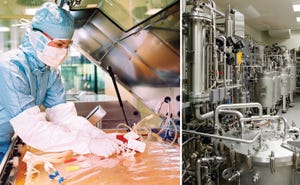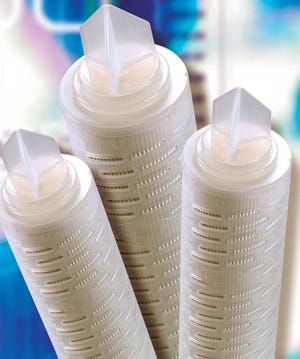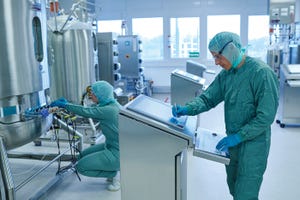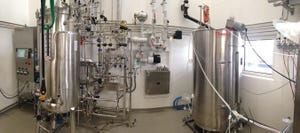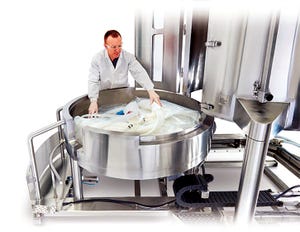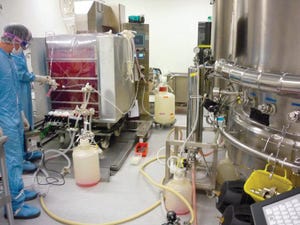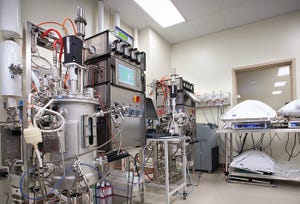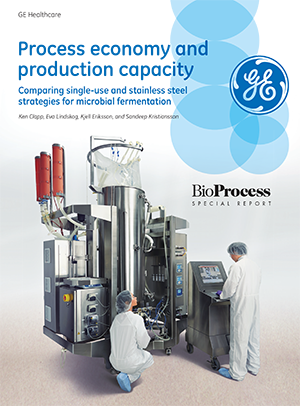December 2015 Supplement
Upstream processing at an IDT Biologika facility in Germany (left) and a SynCo Bio Partners facility in the Netherlands (right) (WWW.IDT-BIOLOGIKA.COM) (WWW.SYNCOBIOPARTNERS.COM)
The increasing penetration of disposable devices in the biopharmaceutical manufacturing industry has been well documented, and with good reason. These applications represent a new paradigm in the evolution of biomanufacturing technologies and practices, opening the industry up to new possibilities such as flexible and modular facilities.
But stainless steel applications and innovations remain vital to this industry. Some stainless devices may be irreplaceable, including large tanks, autoclavable and heat-sterilized fermentors and bioreactors, and storage and filling devices. Other innovations in fluid handling and storage are vital to bioprocessing.
But as the industry transitions from fully stainless steel bioprocessing, to hybrid (or even fully disposable) systems, manufacturing strategies and decisions are changing. Managers a...
Filter cartridges like these are commonly used in facilities that are primarily stainless steel as well as those based on single-use technologies. PALL LIFE SCIENCES (WWW.PALL.COM)
On a holistic level, the decision regarding whether to use single-use or stainless steel equipment in a biomanufacturing plant is a significant one. It greatly influences the design, construction, layout, and operation of a plant — and consequently, the timing and cost of the overall project. And regulatory review can add an element of risk to using anything new. Disposables have been viewed as a revolutionary concept, and they are. But from a routine regulatory operational perspective, I believe it is an evolutionary change rather than a revolutionary one.
Some single-use components are found in even a modern, welldesigned facility based on stainless steel equipment. The industry uses many types of filter cartridges, tubing, and other materials that are (disposable) consumables. Many of them have a finite lifetime, being used ...
Decisions regarding whether and when to use single-use (SU) (disposable) devices or stainless steel (SS) equipment for biopharmaceutical manufacturing have been discussed for more than a decade. To date, no argument in terms of safety, cost-effectiveness, or operational efficiency is fully convincing to choose one technology platform or the other for all applications. Biopharmaceutical companies often do not have in-use data to make strategic manufacturing decisions. But one group has been significantly growing its expertise in use of single-use technologies: contract development and manufacturing organizations (CDMOs). Their general offerings cover fee-for-service activities such as cell line development, process development, and drug substance and drug product manufacturing under good manufacturing practice (GMP).
CDMOs typically operate several manufacturing lines that differ in scale and type of equipment, and they can cultivate eukaryotic or prokaryotic cell types. Facility designs incorporate the us...
Flexible pilot facility with a 350L stainless steel bioreactor and a 1,000-L single-use bioreactor.
Classical stainless steel installations in purpose-built facilities dominate the global capacity for commercial biopharmaceutical manufacturing. Early facilities that were designed for single-product processes are now aging, putting them on the investment radar for upgrades to enable manufacturing diversity, and allow more efficient facility use. More than ever before, global engineering leaders are confronted with complex strategic and financial decisions when they seek to invest capital in new flexible pharmaceutical facilities or flex-grading aging facilities for supply of pipeline products. Manufacturing facilities today are in a more flexible continuum than were facilities 20 years ago.
Figure 1: Flexibility continuum
This flexibility continuum (Figure 1) can be broadly captured at four levels. Starting with process flexibility, that takes into account production mode, mix, scale, and volumes. Ultimate...
Photo 1: The Mobius 2,000-L single-use bioreactor from EMD/Merck Millipore is one company’s response to user needs for safe and ergonomic handling of large singleuse bags. (WWW.EMDMILLIPORE.COM/US/ EN/20150603_201512)
Along with the other perspectives offered in this special issue, people tasked with actually implementing and working with single-use, stainless-steel, or the more common variations of hybrid systems deserve a say also. When seeking out end-user comments, however, we should consider both the overall company decisions about which systems to use (decisions that may not have accommodated much input from the manufacturing floor) and opinions from individual scientists, technicians, and process engineers themselves who are presented with the facility design and expected to make it work.
For this perspective, BPI circulated several questions among some industry contacts and also sought out informal responses through email and during discussions at the recent BPI Conference in Boston, MA (26–30 Oct...
On Tuesday, 21 April 2015, Eric S. Langer (managing partner at BioPlan Associates) chaired a midday roundtable titled, “Deciding on Single-Use vs. Stainless Steel Bioprocessing Strategy: What Do CMOs Know That Biopharmas Don’t?” Langer brought together several industry experts to discuss choosing between stainless steel and single-use technologies (SUTs) for different applications:
Eric Langer (BioPlan Associates)
The decision process regarding whether, when, and where to use stainless steel (SS) and single-use systems (SUSs) for biopharmaceutical manufacturing is complex. So Langer began by introducing the panel’s “true biopharma experts who have made these decisions.” He prefaced the roundtable with a single slide listing “what contract manufacturing organizations (CMOs) know” about this decision process. No convincing data yet suggest that one technology always outperforms others for product safety, cost-effectiveness, or operational efficiency. And most biopharmaceutical development companies don’t ha...
One example of a hybrid approach from Cook Pharmica (WWW.COOKPHARMICA.COM)
At a recent conference, there was much talk about a major biopharmaceutical project in Asia for which the owner of a company chose a design with primarily traditional multiuse stainless steel tanks and processing equipment, rather than single-use polymer equipment. There were even some stainless steel equipment vendors toasting at the bar that this may be the beginning of a “renaissance” of stainless steel.
Is the single-use systems (SUS) honeymoon over? Are many industry professionals hoping this is the end of the single-use “fad”? Is bioprocessing experiencing a dotcom-like balloon trend that is ready to burst?
More likely, single-use technologies have simply reached a plateau, maybe even just a pause. The single-use era has met most of its quick wins. There has been much innovation on the parts of both suppliers and end users, and the industry has realized great gains. It is now time to ensure that this “trend” is not just a pea...
In recent years, single-use technology has been migrating into many unit operations. With the commercial availability of such systems end users have a new option for process development and production that does not rely on operational complexities and utility requirements of conventional sterilize-in-place (SIP) or autoclavable systems.
However, just as for cell culture processes, single-use technology may not apply to each and every fermentation or microbial process. It is the responsibility of practitioners to properly assess their own applications, select appropriate technology, and manage its implementation.
GE Healthcare has compared production capacity and process economy between stainless steel and single-use equipment in microbial processes and presents its study results in this free ebook download.
